Indesit DFG-26B10 User Manual [en, ru, es]

Operating instructions
DISHWASHER
|
EN |
|
ES |
|
TR |
|
|
|
|
|
|
|
|
English, 1 |
Español, 15 |
Türkçe, 29 |
||||
|
|
|
|
|
|
|
|
RU |
|
KZ |
|
|
|
|
|
|
|
|
|
|
|
Русский, 43 |
Қазақша, 59 |
|
|
||
Contents
Product Fiche, 2
Precautions and advice, 3
General safety Disposal
Saving energy and respecting the environment
Installation and Assistance, 4-5
Positioning and levelling
Connecting the water and electricity supplies Advice regarding the first wash cycle Technical data
Assistance
DFG 26B10
Description of the appliance, 6
Overall view Control panel
Loading the racks, 7-8
Lower rack
Cutlery basket
Upper rack
Adjusting the upper rack
Start-up and use, 9
Starting the dishwasher
Measuring out the detergent
Wash cycles, 10
Table of wash cycles
Special wash cycles and Options, 11
Rinse aid and refined salt, 12
Measuring out the rinse aid Measuring out the refined salt
Care and maintenance, 13
Shutting off the water and electricity supplies Cleaning the dishwasher
Preventing unpleasant odours Cleaning the sprayer arms Cleaning the water inlet filter Cleaning the filters
Leaving the machine unused for extended periods
Troubleshooting, 14

Product fiche
|
|
|
|
|
|
|
|
|
|
EN |
|
Product Fiche |
|
|
|
|
Brand |
|
INDESIT |
|
|
|
||
|
|
|
|
|
|
|
Model |
|
DFG 26B10 |
|
|
|
|
|
|
|
Rated capacity in standard place settings (1) |
|
13 |
|
|
|
|
|
|
|
Energy efficiency class on a scale from A+++ (low consumption) to D |
(high consumption) |
A+ |
|
|
|
|
|
|
|
Energy consumption per year in kWh (2) |
|
295.0 |
|
|
|
|
|
|
|
Energy consumption of the standard cleaning cycle in kWh |
|
1.04 |
|
|
|
|
|
|
|
Power consumption of the off-mode in W |
|
0.5 |
|
|
|
|
|
|
|
Power consumption of the left-on mode in W |
|
5.0 |
|
|
|
|
|
|
|
Water consumption per year in litres (3) |
|
3080.0 |
|
|
|
|
|
|
|
Drying efficacy class on a scale from G (low efficacy) to A (high efficacy) |
A |
|
|
|
|
|
|
|
|
Programme time for standard cleaning cycle in minutes |
|
190 |
|
|
|
|
|
|
|
The duration of the left-on mode in minutes |
|
10 |
|
|
|
|
|
|
|
Noise in dB(A) Re 1pW |
|
51 |
|
|
|
|
|
|
|
Built-in model |
|
NO |
|
|
|
|
|
|
|
|
|
|
|
|
NOTES |
|
|
|
|
1) The information on the label and fiche relates to the standard cleaning cycle, this programme is suitable to clean normally |
||
|
|
soiled tableware and it is the most efficient programme in terms of combined energy and water consumption. The standard |
||
|
|
cleaning cycle corresponds to the Eco cycle. |
|
|
|
|
|
||
|
|
2) Based on 280 standard cleaning cycles using cold water fill and the consumption of the low power modes. Actual energy |
||
|
|
consumption depends on how the appliance is used. |
|
|
|
|
|
|
|
|
|
3) Based on 280 standard cleaning cycles. Actual water consumption |
depends on how the appliance is used. |
|
|
|
|
|
|
2

Precautions and advice
 This appliance was designed and manufactured in compliance with international safety standards The following information has been provided for safety reasons and should therefore be read
This appliance was designed and manufactured in compliance with international safety standards The following information has been provided for safety reasons and should therefore be read
carefully.
Keep this instruction manual in a safe place for future reference. If the appliance is sold, given away or moved, please ensure the manual is kept with the
machine.
Please read these instructions carefully: they contain important information on installation, use and safety.
This appliance is designed for domestic use or similar applications, for example:
-staff kitchen areas in shops, offices and other work environments;
-farmhouses;
-use by guests in hotels, motels and other residential settings;
-bed & breakfasts.
General safety
•The appliance should not be operated by people
(including children) with reduced physical, sensory or mental capacities, or by inexperienced people who are not familiar with the product, unless supervision or instructions on how to use it are provided by someone who assumes responsibility for their safety.
•An adult must supervise children at all times to prevent them from playing with the appliance.
•The appliance was designed for domestic use inside the home and is not intended for commercial or industrial use.
•The appliance must be used by adults only to wash domestic crockery in accordance with the instructions in this manual.
•The appliance must not be installed outdoors, even in covered areas. It is extremely dangerous to leave the machine exposed to rain and storms.
•Do not touch the appliance when barefoot.
•When unplugging the appliance always pull the plug from the mains socket. Do not pull on the cable.
•The water supply tap must be shut off and the plug should be removed from the electrical socket before cleaning or maintaining the appliance.
•If the appliance breaks down, do not under any circumstances touch the internal parts in an attempt to perform the repair work yourself.
•Do not lean or sit on the open door of the appliance: this may cause the appliance to overturn.
•The door should not be left open as it may create a dangerous obstacle.
•Keep detergent and rinse aid out of reach of children.
•The packaging material should not be used as a toy for children.
Disposal |
|
|
EN |
||
• Disposal of packaging material: observe local |
||
|
||
legislation so that the packaging may be reused. |
|
|
|
||
• The European Directive 2012/19/EU relating |
|
|
to Waste Electrical and Electronic Equipment |
|
|
(WEEE) states that household appliances should |
|
|
not be disposed of using the normal solid urban |
|
|
waste cycle. Exhausted appliances should be |
|
|
collected separately in order to optimise the re- |
|
|
using and recycling rate of the materials inside the |
|
|
machine, while preventing potential damage to |
|
|
the environment and public health. The crossed- |
|
|
out dustbin symbol is marked on all products to |
|
|
remind the owners of their obligations regarding |
|
|
separated waste collection. |
|
|
For further information relating to the correct |
|
|
disposal of household appliances, owners may |
|
|
contact the relevant public authority or the local |
|
|
appliance dealer. |
|
|
Saving energy and respecting the |
|
|
environment |
|
Saving water and energy
•Only begin a wash cycle when the dishwasher is full. While waiting for the dishwasher to be filled, prevent unpleasant odours using the Soak cycle
(see Wash cycles).
•Select a wash cycle that is suited to the type of crockery and to the soil level of the crockery using the Table of wash cycles:
-for dishes with a normal soil level use the Eco wash cycle, which ensures low energy/water consumption levels.
-If the load is smaller than usual activate the Half
Load option* (see Start-up and use).
•If your electricity supply contract gives details of electricity-saving time bands, run wash cycles when electricity prices are lower. The Delayed
Start button * (see Start-up and use) helps you organise the wash cycles accordingly.
Phosphate-free and chlorine-free detergents containing enzymes
•We strongly recommend that you use detergents that do not contain phosphates or chlorine, as these products are harmful to the environment.
•Enzymes provide a particularly effective action at temperatures around 50°C. As a result detergents containing enzymes can be used in conjunction with low-temperature wash cycles in order to achieve the same results as a normal 65°C wash cycle.
•To avoid wasting detergent, use the product in appropriatequantitiesbasedonthemanufacturer’s recommendations, the hardness of the water, the soil level and the quantity of crockery to be washed. Even if they are biodegradable, detergents contain substances which may alter the balance of nature.
*Only available in selected models.
3
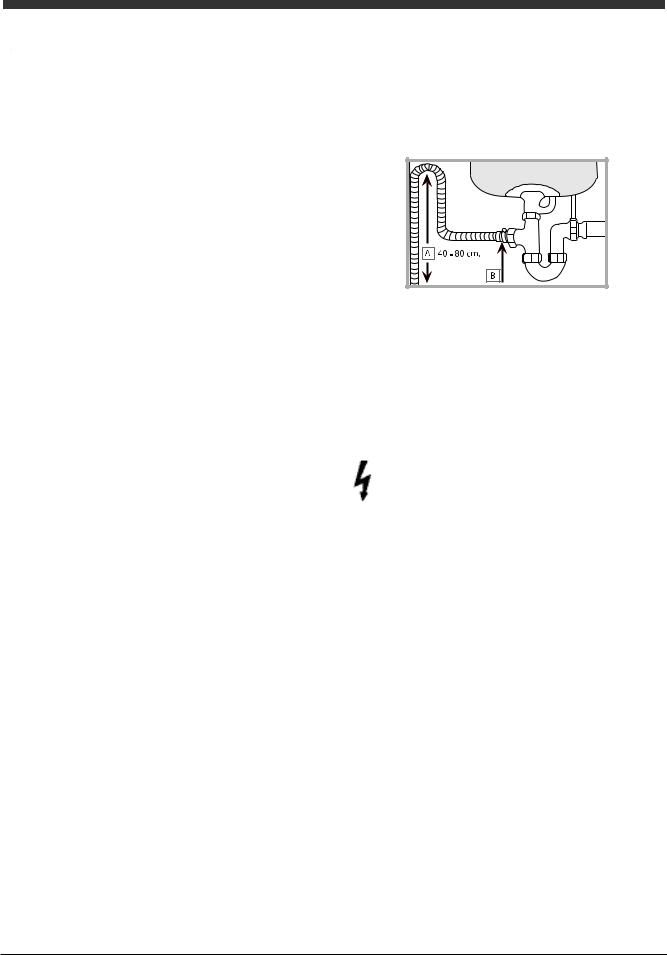
Installation and Assistance
EN |
|
|
If the appliance must be moved at any time, keep it in an |
|
|
|
|||
upright position; if absolutely necessary, it may be tilted onto its |
||||
|
||||
|
back. |
|||
Positioning and levelling
1.Remove the appliance from all packaging and check that it has not been damaged during transportation. If it has been damaged, contact the retailer and do not proceed any further with the installation process.
2.Arrange the dishwasher so that its sides or back panel are in contact with the adjacent cabinets or the wall. This appliance
can also be recessed under a single worktop* (see the Assembly Instruction sheet.)
3. Position the dishwasher on a level sturdy floor. If the floor is uneven, the front feet of the appliance should be adjusted until it reaches a horizontal position. If the appliance is levelled correctly, it will be more stable and much less likely to move or cause vibrations and noise while it is operating.
4*. To adjust the height of the rear foot, turn the red hexagonal bushing on the lower central part at the front of the dishwasher using a hexagonal spanner with an opening of 8 mm. Turn the spanner in a clockwise direction to increase the height and in an anticlockwise direction to decrease it (see Building-in Instruction sheet attached to the documentation.)
Connecting the water and electricity supplies
 Connection to the water and electricity supplies should only be performed by a qualified technician.
Connection to the water and electricity supplies should only be performed by a qualified technician.
 The dishwasher should not stand on the water hoses or electricity supply cable.
The dishwasher should not stand on the water hoses or electricity supply cable.
 The appliance must be connected to the water supply network using new hoses.
The appliance must be connected to the water supply network using new hoses.
Never use old or second hand hose sets. Do not reuse hose sets from any previously installed dishwasher.
The water inlet and outlet hoses and the electricity supply cable may be positioned towards the right or the left in order to achieve the best possible installation.
Connecting the water inlet hose
•To a suitable cold water connection point: before attaching the hose, run the water until it is perfectly clear so that any impurities that may be present in the water do not clog the appliance; after performing this operation, screw the inlet hose tightly onto a tap with a ¾ gas threaded connection.
•To a suitable hot water connection point: your dishwasher may be supplied with hot water from the mains supply (if you have a central heating system with radiators) provided that it does not exceed a temperature of 60°C.
 Screw the hose to the tap as described for connection to a cold water supply.
Screw the hose to the tap as described for connection to a cold water supply.
 If the inlet hose is not long enough, contact a specialist store or an authorised technician (see Assistance.)
If the inlet hose is not long enough, contact a specialist store or an authorised technician (see Assistance.)
 The water pressure must be within the values indicated in the Technical Data table (see adjacent information.)
The water pressure must be within the values indicated in the Technical Data table (see adjacent information.)
The hose should not be bent or compressed.
Connecting the water outlet hose
Connect the outlet hose (without bending it) to a drain duct with a minimum diameter of 4 cm.
The outlet hose must be at a height ranging from 40 to 80 cm from the floor / surface where the dishwasher rests (A).
Before connecting the water outlet hose to the sink drain, remove the plastic plug (B).
Anti-flooding protection
To ensure floods do not occur, the dishwasher:
- is provided with a special system which blocks the water supply in the event of anomalies or leaks from inside the appliance.
Some models are also equipped with the supplementary safety device New Acqua Stop*, which guarantees anti-flooding protection even in the event of a supply hose rupture.
WARNING: HAZARDOUS VOLTAGE!
Under no circumstances should the water inlet hose be cut, as it contains live electrical parts.
Electrical connection
Before inserting the plug into the electrical socket, make sure that:
•The socket is earthed and complies with current regulations.
•the socket can withstand the maximum load of the appliance, which is indicated on the data plate located on the inside of the door
(see Description of the appliance);
•The power supply voltage falls within the values indicated on the data plate on the inside of the door.
•The socket is compatible with the plug of the appliance. If this is not the case, ask an authorised technician to replace the plug (see Assistance); do not use extension cables or multiple sockets.
 Once the appliance has been installed, the power supply cable and the electrical socket should be easily accessible.
Once the appliance has been installed, the power supply cable and the electrical socket should be easily accessible.
 The cable should not be bent or compressed.
The cable should not be bent or compressed.
 If the power supply cable is damaged, it must be replaced by the manufacturer or its Technical Assistance Service in order to prevent all potential hazards (see Assistance.)
If the power supply cable is damaged, it must be replaced by the manufacturer or its Technical Assistance Service in order to prevent all potential hazards (see Assistance.)
* Only available in selected models.
4
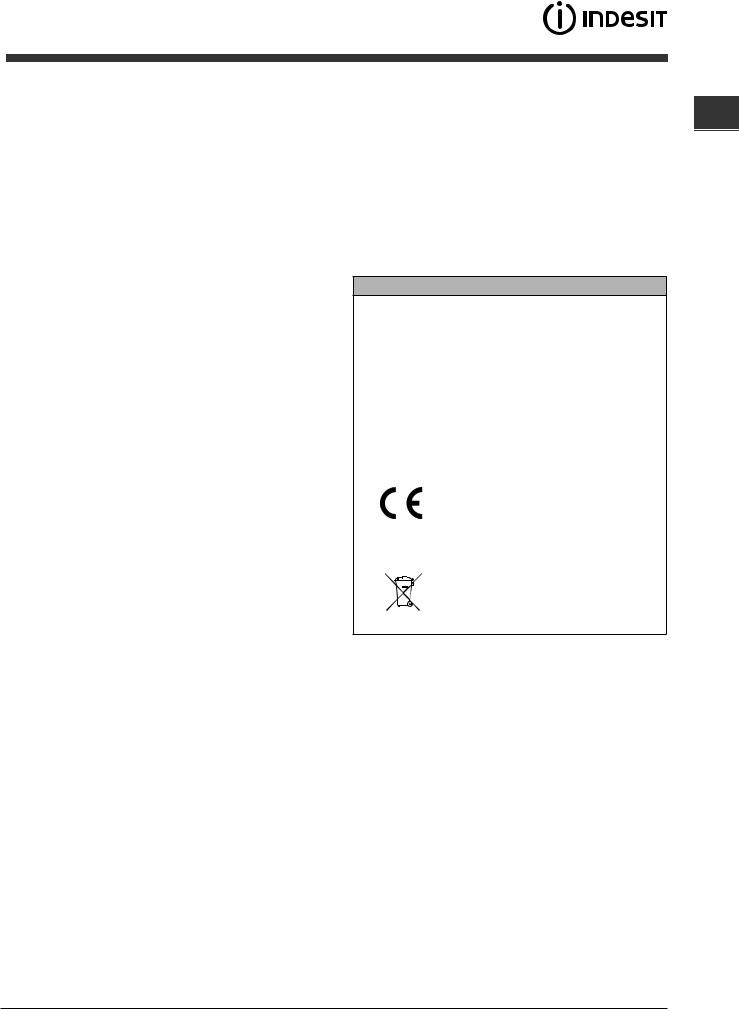
Anti-condensation strip*
After installing the dishwasher, open the door and stick the adhesive transparent strip under the wooden shelf in order to protect it from any condensation which may form.
Advice regarding the first wash cycle
After the installation, remove the stoppers from the racks and the retaining elastic elements from the upper rack, if any. Immediately before the fist washing, completely fill the salt dispenser with water and add only then approximately 1 kg of salt (see chapter entitled Rinse aid and refined salt). The water may overflow: this is normal and is not a cause for concern. Select the water hardness value (see chapter entitled Rinse aid and refined salt). - After the salt has been poured into the machine, the LOW SALT indicator light* switches off.
 If the salt container is not filled, the water softener and the heating element may be damaged as a result.
If the salt container is not filled, the water softener and the heating element may be damaged as a result.
Assistance
Before contacting Assistance:
•Check whether the problem can be resolved using the
Troubleshooting guide (see Troubleshooting).
•Restart the programme to check whether the problem has ceased to exist.
•If the problem persists, contact the Authorised
Technical Assistance Service.
 Never use the services of unauthorised technicians.
Never use the services of unauthorised technicians.
Please have the following information to hand:
•The type of malfunction.
•The appliance model (Mod.).
•The serial number (S/N).
This information can be found on the appliance data plate
(see Description of the appliance).
The machine has a buzzer/set of tones (depending on the dishwasher model) to inform the user that a command has EN been implemented: power on, cycle end etc. *
The symbols/indicator lights/LEDs on the control panel/ display may vary in colour and may have a flashing or fixed light (depending on the dishwasher model).
The display* provides useful information concerning the type of wash cycle, drying/wash-cycle phase, remaining time, temperature etc etc.
Technical data
Dimensions |
width 60 cm |
||
height 85 cm |
|||
|
|
|
depth 60 cm |
Capacity |
13 standard place-settings |
||
|
|
|
|
Water supply pressure |
0,05 ÷ 1MPa (0.5 ÷ 10 bar) |
||
7,25 – 145 psi |
|||
Power supply voltage |
See appliance data plate |
||
|
|
||
Total absorbed power |
See appliance data plate |
||
|
|
||
Fuse |
See appliance data plate |
||
|
|
|
|
|
|
|
This dishwasher conforms to the |
|
|
|
following European Community |
|
|
|
Directives: |
|
|
|
-2006/95/EC (Low Voltage) |
|
|
|
-2004/108/EC (Electromagnetic |
|
|
|
Compatibility) |
|
|
|
-2009/125/EC (Comm. Reg. |
|
|
|
1016/2010) (Ecodesign) |
|
|
|
-97/17/EC (Labelling) |
|
|
|
-2012/19/EU Waste Electrical |
|
|
|
and Electronic Equipment |
|
|
|
(WEEE) |
|
|
|
|
* Only available in selected models.
5
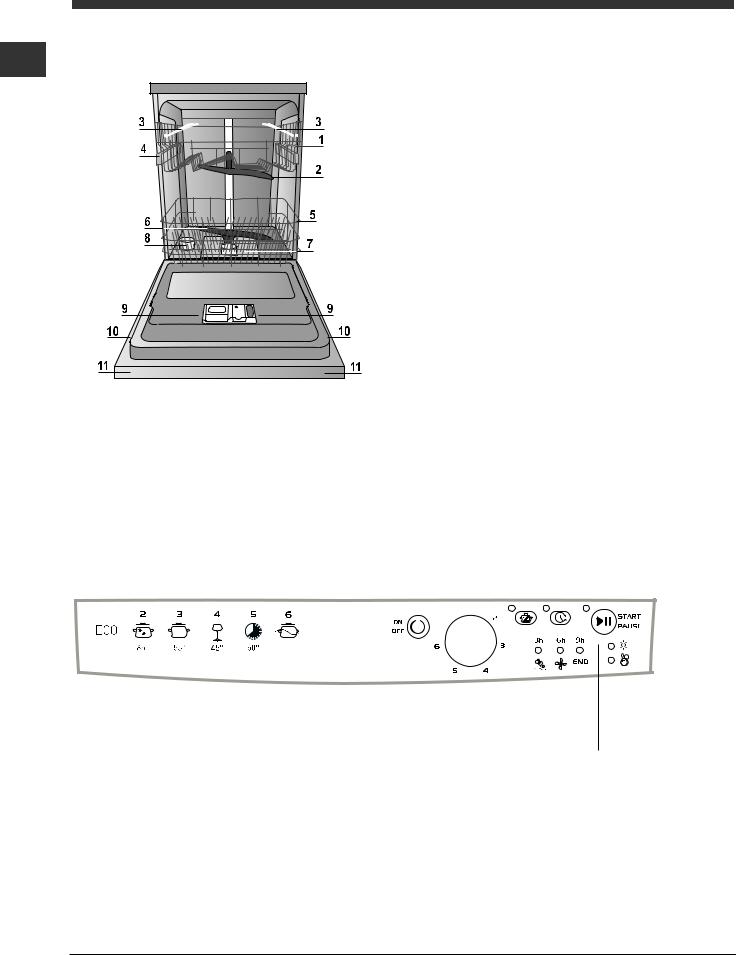
Description of the appliance
EN |
Overall view |
|
1. Upper rack
2. Upper sprayer arm
3. Tip-up dispensers
4. Rack height adjuster
5. Lower rack
6. Lower sprayer arm
7. Washing filter
8. Salt dispenser
9. Detergent dispenser, rinse-aid dispenser and Active Oxygen device*
10. Data plate
11. Control panel***
Control panel
|
|
|
|
|
|
Delayed Start button |
|||||
Half load button and indicator light |
|
and indicator light |
|||||||||
Cycle select knob |
|
|
|
|
|
Start/Pause button and |
|||||
|
|
|
|
|
|||||||
|
|
|
|
|
|||||||
|
|
|
|
|
|||||||
|
|
|
|
|
indicator light |
||||||
|
|
|
|
|
|
|
|
||||
ON/OFF/Reset button |
|
|
|
|
|
|
|
|
|
|
|
|
|
|
|
|
|
|
|
|
|
|
|
|
|
|
|
|
|
|
|
|
|
|
|
|
|
|
|
|
|
|
|
|
|
|
|
|
|
|
|
|
|
|
|
|
|
|
|
|
|
|
|
|
|
|
|
|
|
|
|
|
|
|
|
|
|
|
|
|
|
|
|
|
|
|
|
|
|
|
|
|
|
|
|
|
|
|
|
|
|
|
|
|
|
|
|
Indicator light Washing and Delayed Start 3h. |
|
|
|
Indicator light Low Salt |
|
|
|
||
Indicator light Drying and Delayed Start 6h. |
|
Indicator light |
||
Indicator light Wash Cycle End and Delayed Start 9h. |
Low Rinse Aid |
|||
|
|
|||
***Only in completely built-in models. * Only available in selected models.
The number and type of wash cycles and options may vary depending on the dishwasher model.
6
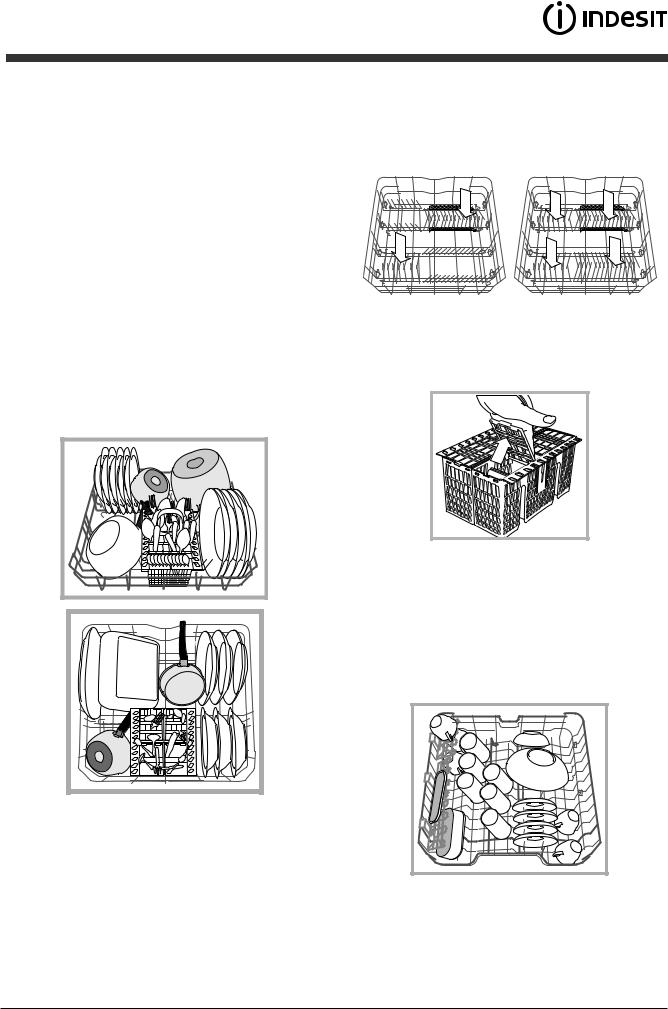
Loading the racks
Tips
Before loading the racks, remove all food residues from the crockery and empty liquids from glasses and containers. No preventive rinsing is needed under running water.
Arrange the crockery so that it is held in place firmly and does not tip over; and arrange the containers with the openings facing downwards and the concave/convex parts placed obliquely, thus allowing the water to reach every surface and flow freely. Make sure that the lids, handles, trays and frying pans do not prevent the sprayer arms from rotating. Place any small items in the cutlery basket.
Since plastic dishes and non-stick frying pans usually retain more water drops, their drying will be not so good as that of ceramic or stainless-steel dishes.
Lightweight items such as plastic containers should be placed in the upper rack and arranged so that they cannot move. After loading the appliance, make sure that the sprayer arms can rotate freely.
Several dishwasher models are fitted with tip-up sectors*. |
EN |
||||
They can be used in a vertical position when arranging dishes |
|||||
|
|||||
or in a horizontal position (lower) to load pans and salad bowls |
|
||||
easily. |
|
||||
|
|
|
|
|
|
|
|
|
|
|
|
|
|
|
|
|
|
|
|
|
|
|
|
Cutlery basket
The basket is equipped with top grilles for improved cutlery arrangement. The cutlery basket should be positioned only at the front of the lower rack
Lower rack
The lower rack can hold pans, lids, dishes, salad bowls, cutlery etc. Large plates and lids should ideally be placed at the sides.
Very soiled dishes and pans should be placed in the lower rack because in this sector the water sprays are stronger and allow a higher washing performance.
*Only available in selected models with different numbers and positions.
 Knives and other utensils with sharp edges must be placed in the cutlery basket with the points facing downwards or they must be positioned horizontally in the tip-up compartments on the upper rack
Knives and other utensils with sharp edges must be placed in the cutlery basket with the points facing downwards or they must be positioned horizontally in the tip-up compartments on the upper rack
Upper rack
Load this rack with delicate and lightweight crockery such as glasses, cups, saucers and shallow salad bowls.
Several dishwasher models are fitted with tip-up sectors*.
They can be used in a vertical position when arranging tea/ dessert saucers or in a lower position to load bowls and food containers.
7
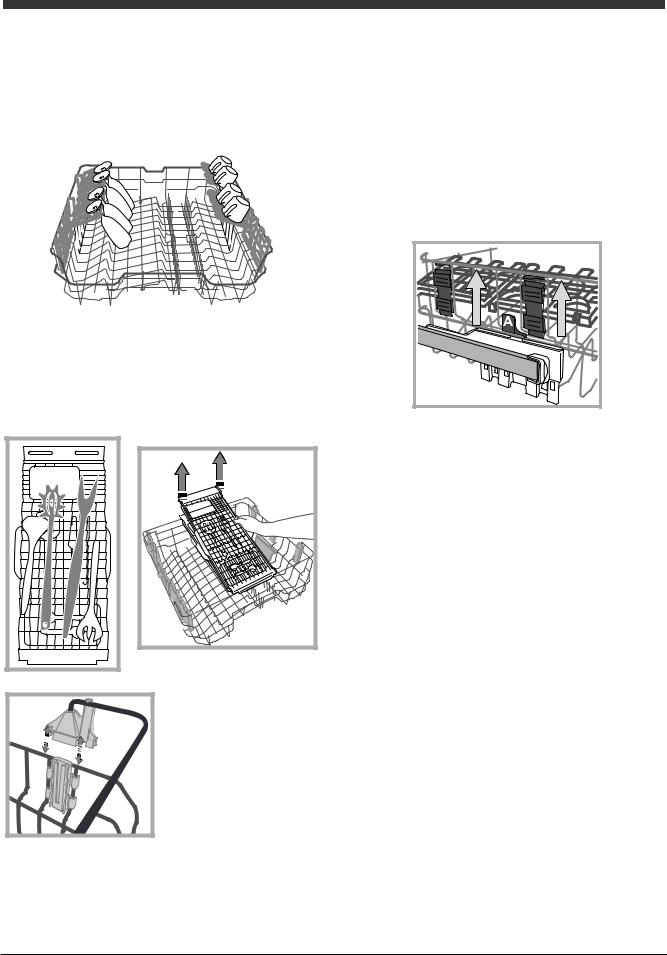
EN |
Tip-up compartments with adjustable position |
|||||
The side tip-up compartments can be positioned at three |
||||||
|
||||||
|
different heights to optimize the arrangement of crockery inside |
|||||
|
||||||
|
the rack. |
|||||
|
Wine glasses can be placed safely in the tip-up compartments |
|||||
|
by inserting the stem of each glass into the corresponding slots. |
|||||
|
|
|
|
|
|
|
|
|
|
|
|
|
|
|
|
|
|
|
|
|
|
|
|
|
|
|
|
Cutlery tray*
Some dishwasher models are fitted with a sliding tray which can be used to hold serving utensils or small cups. For optimum washing performance, avoid positioning bulky crockery directly below the tray.
The cutlery tray can be removed (see Figure).
Before loading the tray, make sure the supports are properly coupled to the upper rack
(see Figure).
Theupperrackcanbeadjustedforheightbasedonrequirements: high position to place bulky crockery in the lower rack and low position to make the most of the tip-up compartments/sectors by creating more space upwards.
Adjusting the height of the upper rack
In order to make it easier to arrange the crockery, the upper rack may be moved to a higher or lower position.
The height of the upper rack should be adjusted WHEN THE RACK IS EMPTY.
NEVER raise or lower the rack on one side only.
If the rack is equipped with a Lift-Up device* (see figure), lift it up by holding its sides. To restore the lower position, press the levers (A) at the sides of the rack and follow the rack down.
Unsuitable crockery
•Wooden crockery and cutlery.
•Delicate decorated glasses, artistic handicraft and antique crockery. Their decorations are not resistant.
•Parts in synthetic material which do not withstand high temperatures.
•Copper and tin crockery.
•Crockery soiled with ash, wax, lubricating grease or ink. The colours of glass decorations and aluminium/silver pieces can change and fade during the washing process. Some types of glass (e.g. crystal objects) can become opaque after a number
of wash cycles too.
Damage to glass and crockery
Caused by:
•Type of glass and glass production process.
•Chemical composition of detergent.
•Water temperature of rinse cycle.
Tips:
•Only use glasses and porcelain guaranteed by the manufacturer as dishwasher safe.
•Use a delicate detergent suitable for crockery.
•Collect glasses and cutlery from the dishwasher as soon as the wash cycle is over.
* Only available in selected models.
8
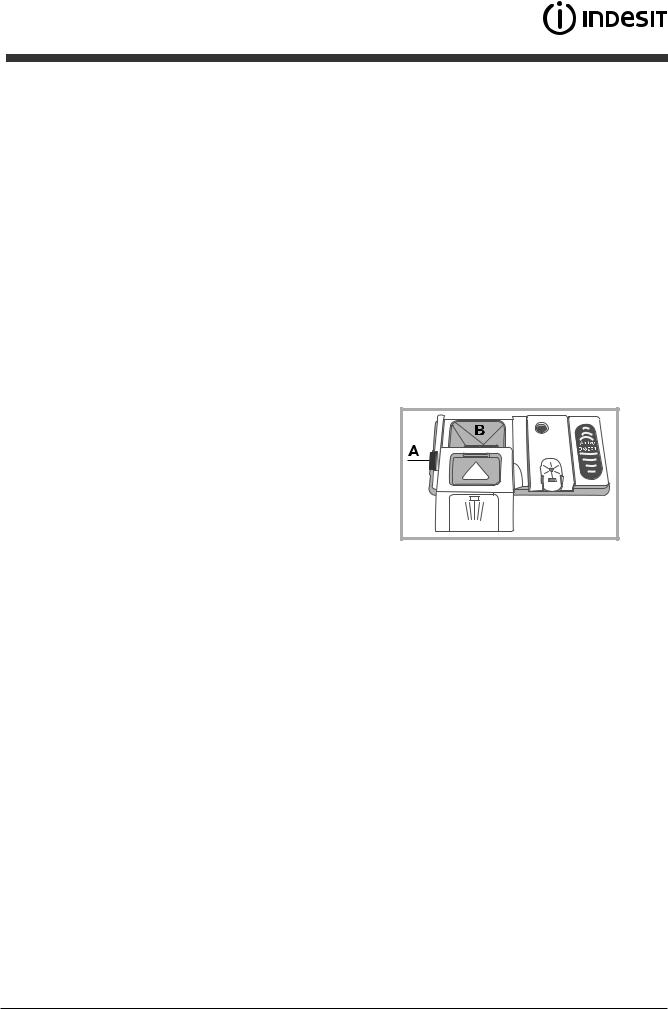
Start-up and use
Starting the dishwasher
1.Turn the water tap on.
2.Switch on the appliance by pressing the ON/OFF button.
3.Open the door and pour in a suitable amount of detergent
(see Measuring out the detergent).
4.Load the racks (see Loading the racks) and shut the door.
5.Select the wash cycle by turning the SELECT WASH CYCLE knob: align the notch on the knob with the number or symbol representing the desired wash cycle. The START/PAUSE indicator light will go on.
6.Select the wash options* (see Options and Special Wash
Cycles).
7.Start the cycle by pressing the START button; the indicator light will stop flashing and stay lit (fixed light). The indicator light corresponding to the wash phase will go on, signalling that the wash cycle has begun.
8.At the end of the wash cycle the END indicator light will go on (fixed light). Switch off the appliance by pressing the ON/OFF button, shut off the water tap and unplug the appliance from the electricity socket.
9.Wait a few minutes before removing the crockery to avoid getting burnt. Unload the racks, beginning with the lower level.
 - The machine will switch off automatically during long periods of inactivity in order to minimise electricity consumption.
- The machine will switch off automatically during long periods of inactivity in order to minimise electricity consumption.
Changing a wash cycle in progress
If a mistake was made in the wash-cycle selection process, it is possible to change the cycle provided that it has only just begun: once the wash cycle has started, in order to change the wash cycle switch off the machine by pressing and holding the ON/ OFF/Reset button. Switch it back on using the same button and select the desired wash cycle and options.
Adding extra crockery
Press the Start/Pause button and open the door, taking care to avoid the escaping steam, and place the crockery inside the dishwasher. Press the Start/Pause button: The cycle will start again after a long beep has been emitted.
 If the delayed start has been set, at the end of the countdown the wash cycle will not start. It will stay in Pause mode.
If the delayed start has been set, at the end of the countdown the wash cycle will not start. It will stay in Pause mode.
 Press the Start/Pause button to pause the machine; the wash cycle is stopped.
Press the Start/Pause button to pause the machine; the wash cycle is stopped.
At this stage the wash cycle cannot be changed.
Accidental interruptions
If the door is opened during the wash cycle or there is a power cut, the cycle stops. It starts again from the point at which it was interrupted once the door has been shut or the electricity supply restored.
* Only available in selected models.
Measuring out the detergent |
|
|
EN |
||
A good wash result also depends on the correct |
||
|
||
amount of detergent being used. Exceeding the stated |
|
|
amount does not result in a more effective wash and |
|
|
increases environmental pollution. |
|
Based on how soiled the items are, the amount can be adjusted to individual cases using powder or liquid detergent.
In the case of normally soiled items, use approximately either 35 gr (powder detergent) or 35 ml (liquid detergent). If tablets are used, one tablet will be enough.
If the crockery is only lightly soiled or if it has been rinsed with water before being placed in the dishwasher, reduce the amount of detergent used accordingly.
For good washing results also follow the instructions shown on the detergent box.
For further questions please ask the detergent producers' Advice Offices.
To open the detergent dispenser use the opening device “A”.
Introduce the detergent into the dry dispenser “B” only. Place the amount of detergent for pre-washing directly inside the tub.
1.When measuring out the detergent refer to the Table of wash cycles to add the proper quantity. Compartment B comprises a level showing the maximum quantity of liquid or powder detergent that can be added to each cycle.
2.Remove detergent residues from the edges of the dispenser and close the cover until it clicks.
3.Close the lid of the detergent dispenser by pulling it up until the closing device is secured in place.
The detergent dispenser automatically opens up at the right time according to the wash cycle.
If all-in-one detergents are used, we recommend using the TABS option, because it adjusts the cycle so that the best washing and drying results are always achieved.
 Only use detergent which has been specifically designed for dishwashers.
Only use detergent which has been specifically designed for dishwashers.
DO NOT USE washing-up liquid.
Using excessive detergent may result in foam residue remaining in the machine after the cycle has ended.
The use of tablets is only recommended for models which offer the MULTI-FUNCTIONAL TABLETS option.
To achieve the best results from each washing and drying cycle, powder detergent, liquid rinse aid and salt should be used.
9

Wash cycles
|
|
|
|
|
|
|
|
|
|
|
|
|
Wash-cycle data is measured under laboratory conditions according to European Standard EN 50242. |
||||||||
EN |
|
|||||||||
|
Based on the different conditions of use, the wash-cycle duration and data can change. |
|
|
|||||||
|
|
|
|
|||||||
|
|
|
The number and type of wash cycles and options may vary depending on the dishwasher model. |
|
|
|||||
|
|
|
|
|
||||||
|
|
|
|
|
||||||
|
|
|
|
|
|
|
|
|
|
|
|
|
|
|
|
|
Wash Cycle |
Water |
|
Energy |
|
|
|
|
Wash Cycle |
Drying |
Options |
Consumption (l/ |
|
Consumption |
|
|
|
|
|
Duration |
|
|
|||||
|
|
|
|
|
|
cycle) |
|
(kWh/cycle) |
|
|
|
|
|
|
|
|
|
|
|
||
|
|
1. |
Eco |
Yes |
Half Load - Delayed Start |
03:10’ |
11,0 |
|
1,04 |
|
|
|
|
|
|
|
|
|
|
|
|
|
|
2. |
Intensive |
Yes |
Half Load - Delayed Start |
02:30’ |
16,5 |
|
1,70 |
|
|
|
|
|
|
|
|
|
|
|
|
|
|
3. |
Normal |
Yes |
Half Load - Delayed Start |
02:00’ |
16,0 |
|
1,35 |
|
|
|
|
|
|
|
|
|
|
|
|
|
|
4. |
Delicates |
Yes |
Half Load - Delayed Start |
01:30’ |
12,0 |
|
1,10 |
|
|
|
|
|
|
|
|
|
|
|
|
|
|
5. |
Rapid 40’ |
No |
Delayed Start |
00:40’ |
9,0 |
|
0,95 |
|
|
|
|
|
|
|
|
|
|
|
|
|
|
6. |
Prewash |
No |
Half Load - Delayed Start |
00:10’ |
4,0 |
|
0,01 |
|
|
|
|
|
|
|
|
|
|
|
|
Instructions on wash-cycle selection and detergent dosage
1. The ECO wash cycle is the standard cycle to which the energy label data refers. It can be used to wash crockery with a normal soil level and is the most efficient cycle in terms of energy and water consumption for this type of crockery.
27 gr/ml + 6 gr/ml** – 1 Tab (**Quantity of pre-washing detergent)
2.Heavily soiled dishes and pans (not to be used for delicate items). 30 gr/ml – 1 Tab
3.Normally soiled pans and dishes. 27 gr/ml + 6 gr/ml** – 1 Tab
4.Economic and fast wash for delicate items which are sensitive to high temperatures. 30 gr/ml – 1 Tab
5.Fast cycle to be used for slightly dirty dishes (ideal for 2 place settings) 25 gr/ml – 1 Tab
6.Pre-wash while awaiting completion of the load with the dishes from the next meal. No detergent.
Standby consumption: Left-on mode consumption: 5,0 W - Off mode consumption: 0.5 W
10

Special wash cycles and Options
Notes:
Optimum performance levels when using the “"Rapid” cycle can be achieved by respecting the specified number of place settings.
To reduce consumption even further, only run the dishwasher when it is full.
Note for Test Laboratories: for information on comparative EN testing conditions, please send an email to the following address: assistenza_en_lvs@indesitcompany.com
Wash options*
The OPTIONS may only be set, changed or reset after the wash cycle has been selected and before the Start/ Pause button has been pressed.
Only the options which are compatible with the type of wash cycle set may be selected. If an option is not compatible with the selected wash cycle (see Table of wash cycles), the corresponding symbol/LED flashes rapidly 3 times.
If an option is selected which is not compatible with another previously-selected option, it will flash 3 times and go off, while the most recently selected option will remain active.
To deselect an option which has been set by mistake, press the corresponding button again.
Half load |
EN |
If there are not many dishes to be washed, a half |
|
load cycle may be used in order to save water, electricity |
|
and detergent. Select the wash cycle and press the HALF |
|
LOAD button; the indicator light will go on. |
|
Press the HALF LOAD button again to deselect this option.
Remember to halve the amount of detergent.
Delayed start
It is possible to delay the start time of the wash cycle by 3, 6 or 9 hours:
1:After selecting the desired wash cycle and any other options, press the DELAYED START button. the indicator light will go on.
2: Select the desired delay time by pressing the Delayed
Start button repeatedly. The wash phase (3 hours), drying phase (6 hours) and end (9 hours) indicator lights will go on in succession.
If the Delayed Start button is pressed again, the option is deselected and the indicator light goes off.
3. After the selection process, the countdown will begin if the Start/Pause button is pressed. The selected delay-period indicator light flashes and the Start/Pause button stops flashing (fixed light).
3. Once this time has elapsed, the DELAYED START indicator light goes off and the wash cycle begins.
The Delayed Start function cannot be set once a wash cycle has started.
* Only available in selected models.
11
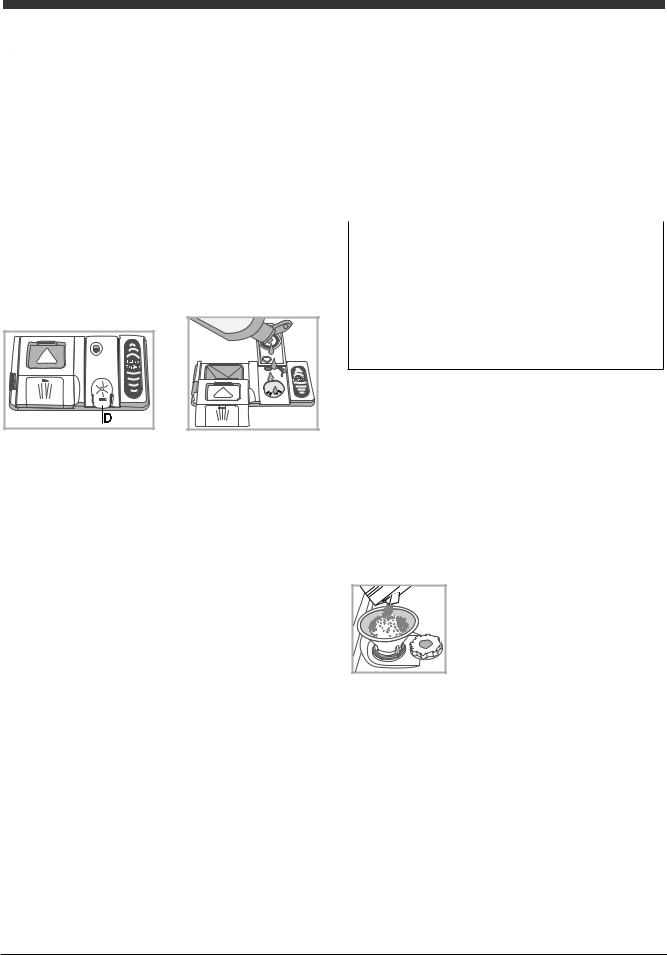
Rinse aid and refined salt
EN |
|
|
Only use products which have been specifically designed |
|
|
||
|
for dishwashers. |
||
|
|
||
|
|
Do not use table/industrial salt or washing-up liquid. |
|
|
|
Follow the instructions given on the packaging. |
|
 If using a multi-functional product it is not necessary to add any rinse aid. However, we recommend that you add salt, especially if you live in an area where the water is hard or very hard. (Follow the instructions given on the packaging).
If using a multi-functional product it is not necessary to add any rinse aid. However, we recommend that you add salt, especially if you live in an area where the water is hard or very hard. (Follow the instructions given on the packaging).
 If you do not add salt or rinse aid, the LOW SALT* and LOW RINSE AID* indicator lights will stay lit.
If you do not add salt or rinse aid, the LOW SALT* and LOW RINSE AID* indicator lights will stay lit.
Measuring out the rinse aid
Rinse aid makes it easier for the crockery to dry, as water runs off the surfaces more readily and therefore does not leave streaks or marks. The rinse aid dispenser should be filled:
•When the LOW RINSE AID indicator light* on the control panel is illuminated, a reserve supply of rinse aid is still available for 1-2 cycles;
A |
X |
M |
1.Open the dispenser “D” by pressing and pulling up the tab on the lid;
2.Carefully introduce the rinse aid as far as the maximum reference notch of the filling space - avoid spilling it. If this happens, clean the spill immediately with a dry cloth.
3.Press the lid down until you hear a click to close it.
NEVER pour the rinse aid directly into the appliance tub.
Adjusting the amount of rinse aid
If you are not completely satisfied with the drying results, you can adjust the quantity of rinse aid. Switch the dishwasher on and off using the ON/OFF button. Press the Start/Pause button 3 times; switch on the machine using the ON/OFF button and access the adjustment menu - the rinse-aid indicator light is lit
(set to factory level).
Adjust the level of rinse aid supply using the WASH CYCLE SELECT knob. There is a rinse aid level for each wash cycle (0 to 4 max).
Press the ON/OFF button to save the setting.
If the rinse aid level is set to ZERO (ECO), no rinse aid will be supplied. The LOW RINSE AID indicator light will not be lit if you run out of rinse aid.
•If there are streaks on the crockery, set a low number (1-2).
•If there are drops of water or limescale marks, set a high number (3-4).
Setting the water hardness
Every dishwasher is equipped with a water softener which, by using refined salt designed specially for this type of appliance, supplies water without limescale which is then used to wash the crockery.
This dishwasher has a setting that helps reduce pollution and optimises washing performance in accordance with the water
hardness level in your area. Ask your local water supplier for this information.
- Switch on the dishwasher using the ON/OFF button, wait a few seconds and switch it off using the ON/OFF button. Hold down the Start/Pause button for min. 3 seconds; switch on the machine using the ON/OFF button and access the adjustment menu - the salt indicator light is lit.
-Select the desired level using the SELECT WASH CYCLE knob
(1 to 5* Max.)
(water softener set to medium level).
Press the ON/OFF button to save the setting.
Even if using multi-functional tablets, fill the salt dispenser.
Water Hardness Table |
|
Average salt dispenser |
|||
|
capacity duration** |
||||
level |
°dH |
°fH |
mmol/l |
months |
|
1 |
0 |
- 6 |
0 - 10 |
0 - 1 |
7 months |
2 |
6 - 11 |
11 - 20 |
1,1 - 2 |
5 months |
|
3 |
12 |
- 17 |
21 - 30 |
2,1 - 3 |
3 months |
4 |
17 |
- 34 |
31 - 60 |
3,1 - 6 |
2 months |
5* |
34 |
- 50 |
61 - 90 |
6,1 - 9 |
2/3 weeks |
For values between 0°f and 10°f, we do not recommend the use of salt. * a setting of 5 may increase cycle duration.
** 1 wash cycle per day.
(°dH = hardness measured in German degrees - °f = hardness measured in French degrees – mmol/l = millimoles per litre)
Measuring out the refined salt
In order to obtain the best possible results from a wash cycle, make sure that the salt dispenser is never empty.
Refined salt removes limescale from the water, thus avoiding the formation of deposits on crockery.
The salt dispenser is located in the lower part of the dishwasher (see Description) and should be filled:
•When the green float* cannot be seen by simply looking at the cap of the salt dispenser;
•When the LOW RINSE AID indicator light on the control panel
is illuminated *;
1. Remove the lower rack and unscrew
the cap (anticlockwise).
2. The first time you do this: fill the water
tank right up to its edge.
3. Position the funnel* (see figure) and
fill the salt dispenser up to the edge
(approximately 1 kg). It is normal for a
little water to leak out.
4. Remove the funnel* and wipe any salt residues away from the opening; rinse the cap under running water and then screw it on, the head facing downwards so as to let the water flow out of the four slots (star-shaped arrangement) in the lower part of
the cap (cap with green float*).
It is advisable to perform this procedure every time you add salt to the dispenser.
Make sure the cap is screwed on tightly so that no detergent can get into the container during the wash cycle (this could damage the water softener beyond repair).
 When necessary, measure out the salt before a wash cycle so that any saline solution which has leaked out of the salt dispenser is removed.
When necessary, measure out the salt before a wash cycle so that any saline solution which has leaked out of the salt dispenser is removed.
* Only available in selected models.
12
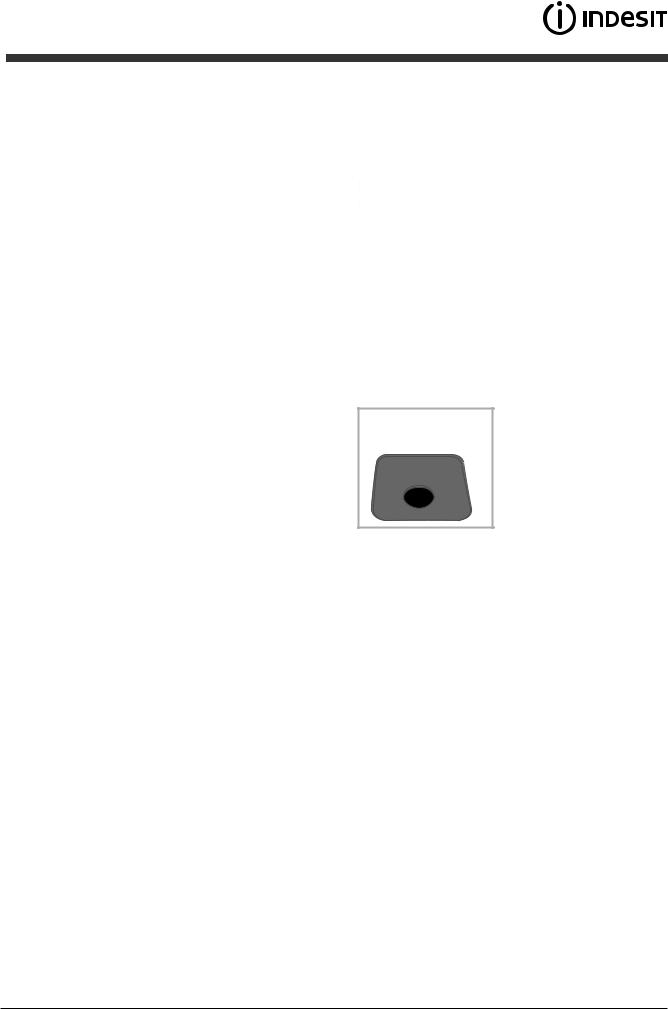
Care and maintenance
Shutting off the water and electricity |
|
supplies |
|
• |
Turn off the water tap after every wash cycle to avoid leaks. |
• |
Always unplug the appliance when cleaning it and when |
|
performing maintenance work. |
Cleaning the dishwasher |
|
• |
The external surfaces of the machine and the control panel |
|
can be cleaned using a non-abrasive cloth which has been |
|
dampened with water. Do not use solvents or abrasive |
|
products. |
• |
Any marks on the inside of the appliance may be removed |
|
using a cloth dampened with water and a little vinegar. |
Preventing unpleasant odours |
|
• |
Always keep the door of the appliance ajar in order to avoid |
|
moisture from forming and being trapped inside the machine. |
• |
Clean the seals around the door and detergent dispensers |
|
regularly using a damp sponge. This will avoid food becoming |
|
trapped in the seals, which is the main cause behind the |
|
formation of unpleasant odours. |
Cleaning the sprayer arms |
|
Food residue may become encrusted onto the sprayer arms |
|
and block the holes used to spray the water. It is therefore |
|
recommended that you check the arms from time to time and |
|
clean them with a small non-metallic brush. |
|
The two sprayer arms may both be removed. |
|
|
To remove the upper sprayer arm, |
|
turn the plastic locking ring in an |
|
anti-clockwise direction. The upper |
|
sprayer arm should be replaced |
|
so that the side with the greater |
|
number of holes is facing upwards. |
The lower sprayer arm can be |
removed by pressing on the side |
tabs and pulling it upwards. |
Cleaning the water inlet filter* |
If the water hoses are new or have not been used for an extended period of time, let the water run to make sure it is clear and free of impurities before performing the necessary connections. If this precaution is not taken, the water inlet could become blocked and damage the dishwasher.
 Clean the water inlet filter at the tap outlet regularly.
Clean the water inlet filter at the tap outlet regularly.
-Turn off the water tap.
-Unscrew the end of the water inlet hose, remove the filter and clean it carefully under running water.
-Re-place the filter and screw the water hose back into position.
Cleaning the filters |
|
||
EN |
|||
The filter assembly consists of three filters which remove food |
|||
|
|||
residues from the washing water and then recirculate the water. |
|
||
They should be cleaned if you wish to achieve the best results |
|
||
in every wash. |
|
||
|
Clean the filters regularly. |
|
|
|
|
||
|
|
||
|
The dishwasher should not be used without filters or if the |
|
|
|
|
||
|
|
||
filter is loose. |
|
||
• After several washes, check the filter assembly and if necessary clean it thoroughly under running water, using a non-metallic brush and following the instructions below:
1.Turn the cylindrical filter C in an anti-clockwise direction and pull it out (fig. 1).
2.Remove the cup filter B by exerting a slight pressure on the side flaps (fig. 2);
3.Slide out the stainless-steel plate filter A. (fig. 3).
4.Inspect the trap and remove any food residues. NEVER
REMOVE the wash-cycle pump protection (black detail) (fig.4).
After cleaning the filters, re-place the filter assembly and fix it in position correctly; this is essential for maintaining the efficient operation of the dishwasher.
Leaving the machine unused for extended periods
•Disconnect the appliance from the electricity supply and shut off the water tap.
•Leave the door of the appliance ajar.
•When you return, run a wash cycle when the dishwasher is empty.
* Only available in selected models.
13

Troubleshooting
|
|
|
|
|
|
Whenever the appliance fails to work, check for a solution from the following list before calling for Assistance. |
|
EN |
|
||
|
|
|
|
|
|
|
|
|
|
Problem: |
Possible causes / solutions: |
|
|
The dishwasher cannot be started or |
• Switch off the appliance by pressing the ON/OFF button. Switch it back on |
|
|
controlled. |
after approximately one minute and reset the program. |
|
|
|
• The appliance has not been plugged in properly. |
|
|
|
• The dishwasher door has not been shut properly. |
|
|
The door won’t close. |
• The lock was released. Strongly push the door until a “clacking” noise is |
|
|
heard. |
|
|
|
|
|
|
|
No water drains from the |
• The dishwasher cycle has not finished yet. |
|
|
dishwasher. |
• The water drain hose is bent (see Installation). |
|
|
|
• The drain duct is blocked. |
|
|
|
• The filter is clogged up with food residues. |
|
|
The dishwasher is too noisy. |
• The dishes are rattling against each other or against the sprayer arms. |
|
|
|
• An excessive amount of foam has been produced: the detergent has not been |
|
|
|
measured out correctly or it is not suitable for use in dishwashers (see Start- |
|
|
|
up and use). |
|
|
The dishes and glasses are |
• The level of refined salt is low or the dosage setting is not suited to the |
|
|
covered in a white film or |
hardness of the water (see Rinse aid and salt). |
|
|
limescale deposits. |
• The lid on the salt dispenser was not closed properly. |
|
|
|
• The rinse aid has been used up or the dosage is too low. |
|
|
The dishes and glasses are |
• The rinse aid dosage is too high. |
|
|
streaked or have a bluish |
|
|
|
tinge. |
|
|
|
The crockery has not been |
• A wash cycle without a drying cycle has been selected. |
|
|
dried properly. |
• The rinse aid has been used up or the dosage is too low (see Rinse aid and |
|
|
|
salt). |
|
|
|
• The rinse aid setting is not suitable. |
|
|
|
• The crockery is made from non-stick material or plastic. |
|
|
The crockery is not clean. |
• The racks are overloaded (see Loading the racks.) |
|
|
|
• The crockery has not been arranged properly. |
|
|
|
• The sprayer arms cannot move freely. |
|
|
|
• The wash cycle is too gentle (see Wash cycles). |
|
|
|
• An excessive amount of foam has been produced: the detergent has not been |
|
|
|
measured out correctly or it is not suitable for use in dishwashers (see Start- |
|
|
|
up and use). |
|
|
|
• The lid on the rinse aid compartment was not shut correctly. |
|
|
|
• The filter is dirty or blocked (see Care and maintenance). |
|
|
|
• The refined salt level is low (see Rinse aid and salt). |
|
|
The dishwasher does not take |
• There is no water in the mains supply. |
|
|
any water in - Tap shut-off |
• The water inlet hose is bent (see Installation). |
|
|
alarm. |
• Turn on the tap and the appliance will start after a few minutes. |
|
|
(The Drying and End indicator lights |
• The appliance stopped because no action was taken when the beep |
|
|
flash quickly.) |
sounded*. (*Only available on selected models.) |
|
|
|
Switch off the machine using the ON/OFF button, turn on the tap and switch |
|
|
|
the machine back on after 20 seconds by pressing the same button. Reset the |
|
|
|
appliance and restart the wash cycle. |
* Only available in selected models.
14

Manual de Instrucciones
ES
Español, 15
DFG 26B10
LAVAVAJILLAS
Sumario
Ficha del producto, 16
Precauciones y consejos, 17
Seguridad general
Eliminación
Ahorrar y respetar el medio ambiente
Instalación y Asistencia, 18-19
Colocación y nivelación
Conexiones hidráulicas y eléctricas
Datos técnicos
Advertencias para el primer lavado
Asistencia
Descripción del aparato, 20
Vista de conjunto
Panel de mandos
Cargar los cestos, 21-22
Cesto inferior
Cesto de los cubiertos
Cesto superior
Regulación del cesto superior
Puesta en funcionamiento y uso, 23
Poner en funcionamiento el lavavajillas Cargar el detergente
Programas, 24
Tabla de programas
Programas especiales y opciones, 25
Abrillantador y sal regeneradora, 26
Cargar el abrillantador Cargar la sal regeneradora
Mantenimiento y cuidados, 27
Interrumpir el agua y la corriente eléctrica Limpiar el lavavajillas
Evitar los malos olores Limpiar los rociadores
Limpieza del filtro de entrada de agua Limpiar los filtros
Si se ausenta durante largos períodos
Anomalías y soluciones,28
15

Ficha del producto
|
|
|
|
|
|
|
|
|
|
ES |
|
|
|
|
|
Ficha del producto |
|
|
|
|
|
|
|
|
|
|
Marca |
INDESIT |
|
|
|
|
|
|
|
|
Modelo |
DFG 26B10 |
|
|
|
|
|
|
|
|
Capacidad nominal en número de cubiertos estándar (1) |
13 |
|
|
|
|
|
|
|
|
Clase de eficiencia energética sobre una escala de A+++ (bajo consumo) a D (alto consumo) |
A+ |
|
|
|
|
|
|
|
|
Consumo energético anual en kWh (2) |
295.0 |
|
|
|
|
|
|
|
|
Consumo energético del ciclo de lavado estándar en kWh |
1.04 |
|
|
|
|
|
|
|
|
Consumo de potencia en el modo apagado en W |
0.5 |
|
|
|
|
|
|
|
|
Consumo de potencia en el modo espera en W |
5.0 |
|
|
|
|
|
|
|
|
Consumo de agua anual en litros (3) |
3080.0 |
|
|
|
|
|
|
|
|
Clase de eficacia de secado sobre una escala de G (eficacia mínima) a A (eficacia máxima) |
A |
|
|
|
|
|
|
|
|
Duración del programa por ciclo de lavado estándar en minutos |
190 |
|
|
|
|
|
|
|
|
Duración del modo espera en minutos |
10 |
|
|
|
|
|
|
|
|
Nivel de ruido en dB(A) re 1 pW |
51 |
|
|
|
|
|
|
|
|
Modelo de encastre |
No |
|
|
|
|
|
|
|
|
|
|
|
|
|
NOTAS |
|
|
|
|
1) La información contenida en la etiqueta y la ficha se refiere al ciclo estándar de lavado, este programa está diseñado para lavar |
|
|
|
|
normalmente vajillas manchadas y es el programa más eficiente en términos de consumo combinado de agua y energía. El ciclo |
|
|
|
|
estándar de lavado se corresponde con el ciclo Eco. |
|
|
|
|
|
|
|
|
|
2) Basado en 280 ciclos de lavado estándar con agua fría y consumo de modos de bajo consumo energético. El consumo actual |
|
|
|
|
dependerá de cómo se utilice el aparato. |
|
|
|
|
|
|
|
|
|
3) Basado en 280 ciclos de lavado estándar. El consumo actual de agua depende de cómo se utilice el aparato. |
|
|
|
|
|
|
|
16

Precauciones y consejos
 El aparato ha sido proyectado y fabricado en conformidad con las normas internacionales de seguridad Estas advertencias se suministran por razones de seguridad y deben ser leídas atentamente.
El aparato ha sido proyectado y fabricado en conformidad con las normas internacionales de seguridad Estas advertencias se suministran por razones de seguridad y deben ser leídas atentamente.
Es importante conservar este manual para poder consultarlo en cualquier momento. En caso de venta, de cesión o de traslado, el manual debe permanecer junto al aparato.
Lea atentamente las instrucciones: contienen información importante sobre la instalación, sobre el uso y sobre la seguridad.
Este aparato ha sido proyectado para uso doméstico y para aplicaciones similares, por ejemplo:
-áreas destinadas a cocina, para el personal en tiendas, oficinas y otros ambientes de trabajo;
-cortijos;
-uso por parte de clientes en hoteles, moteles y otros ambientes de tipo residencial;
-alojamientos con desayuno.
Seguridad general
•Este electrodoméstico no puede ser utilizado por niños ni por personas con capacidades físicas, sensoriales o psíquicas reducidas, o carentes de la experiencia y los conocimientos necesarios para utilizarlo, salvo que lo hagan bajo la vigilancia o las instrucciones de una persona responsable de su seguridad.
•Es necesaria la vigilancia de un adulto para que los niños no jueguen con el electrodoméstico.
•El aparato ha sido fabricado para un uso de tipo no profesional en el interior de una vivienda.
•El aparato debe ser utilizado para el lavado de vajilla de uso doméstico, sólo por personas adultas y según las instrucciones contenidas en este manual.
•El aparato no se debe instalar al aire libre, ni siquiera si el lugar está protegido, porque es muy peligroso dejarlo expuesto a la lluvia o a las tormentas.
•No tocar el lavavajillas con los pies descalzos.
•No desconectar la clavija de la toma de corriente tirando del cable sino sujetando la clavija.
•Es necesario cerrar el grifo de agua y desconectar la clavija de la toma de corriente antes de realizar operaciones de limpieza y mantenimiento.
•En caso de avería, no acceder nunca a los mecanismos internos para intentar su reparación.
•No apoyarse ni sentarse sobre la puerta abierta: el aparato podría voltearse.
•La puerta no debe dejarse abierta, ya que podría causar tropiezos.
•Conservar el detergente y el abrillantador fuera del alcance de los niños.
•Los embalajes no son juguetes para los niños.
Eliminación |
|
|
ES |
||
• Eliminación del material de embalaje: respetar las |
||
|
||
normas locales para que los embalajes puedan |
|
|
|
||
ser reutilizados. |
|
•La norma Europea 2012/19/EU sobre desechos de equipos eléctricos y electrónicos (DEEE) establece que los electrodomésticos no se deben eliminar junto con los desechos sólidos urbanos comunes. Los aparatos eliminados deben ser recogidos en forma separada para optimizar la tasa de recuperación y reciclado de los materiales que los componen e impedir que provoquen daños a la salud y el medio ambiente. El símbolo del cubo tachado se encuentra en todos los productos para recordar la obligación de recolección separada.
Para mayor información sobre la correcta eliminación de los electrodomésticos, los propietarios podrán dirigirse al servicio público encargado de la recolección o a los revendedores.
Ahorrar y respetar el medio ambiente
Ahorrar agua y energía
•Poner en funcionamiento el lavavajillas sólo con plena carga. A la espera de que la máquina esté llena, prevenir los malos olores con el ciclo Remojo (ver Programas).
•Seleccionar un programa adecuado al tipo de vajilla y al grado de suciedad consultando la Tabla de programas:
-para la vajilla con suciedad normal utilizar el programa Eco, que garantiza un bajo consumo energético y de agua.
-si la carga es reducida, activar la opción Media carga* (ver Puesta en funcionamiento y uso).
•Si el suministro de energía eléctrica prevé horarios de ahorro energético, realizar los lavados en los horarios con tarifa reducida. La opción Inicio diferido* (ver Puesta en funcionamiento y uso) puede ayudar a organizar los lavados en ese sentido.
Detergentes sin fosfatos, sin cloro y con contenido de enzimas
•Se aconseja utilizar detergentes sin fosfatos y sin cloro, que son los más indicados para proteger el medio ambiente.
•Las enzimas ejercen una acción particularmente eficaz con temperaturas próximas a los 50°C, por lo tanto, utilizando detergentes con enzimas se pueden elegir lavados a bajas temperaturas y obtener los mismos resultados que si se realizaran a 65°C.
•Para evitar derroches, dosificar el detergente correctamente, teniendo en cuenta las indicaciones del fabricante, la dureza del agua, el grado de suciedad y la cantidad de vajilla. Aún siendo biodegradables, los detergentes contienen elementos que alteran el equilibrio de la naturaleza.
17
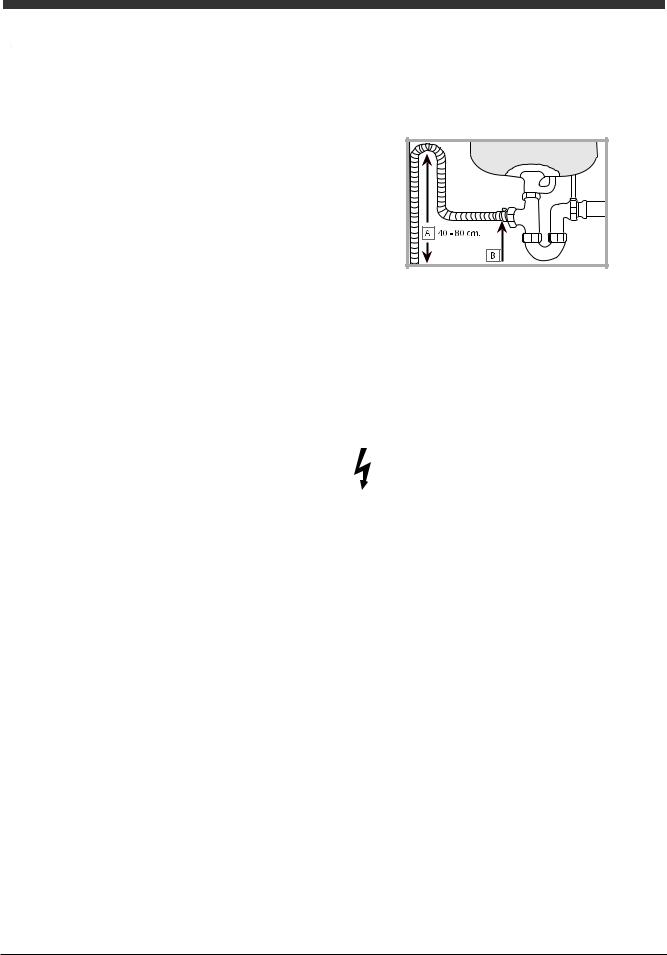
Instalación y Asistencia Técnica
|
|
|
En caso de traslado mantener el aparato en posición vertical; |
|
ES |
||||
|
|
|||
|
si fuera necesario inclinarlo, hacerlo hacia la parte posterior. |
|||
|
|
|||
|
|
|
|
|
Colocación y nivelación
1.Desembalar el aparato y comprobar que no haya sufrido daños durante el transporte. Si estuviera dañado, no conectarlo; llamar al revendedor.
2.Colocar el lavavajillas haciendo adherir los costados o la parte
posterior a los muebles adyacentes o a la pared. El aparato se puede empotrar debajo de una encimera continua* (ver hoja de Montaje).
3.Emplazar el lavavajillas sobre un piso plano y rígido.
Compensar las irregularidades desenroscando o enroscando las patas delanteras hasta que el aparato esté en posición horizontal. Una cuidadosa nivelación asegura estabilidad y evita vibraciones, ruidos y desplazamientos.
4*. Para regular la altura de la pata posterior, accionar el casquillo hexagonal rojo que se encuentra en la parte inferior frontal y central del lavavajillas, utilizando una llave de boca hexagonal con una apertura de 8 mm girando en sentido horario para aumentar la altura y en sentido antihorario para disminuirla.
(Ver la hoja de instrucciones para empotrado adjunta a la documentación.)
Conexiones hidráulicas y eléctricas
 La adaptación de las redes eléctricas e hidráulicas para la instalación debe ser realizada sólo por personal especializado.
La adaptación de las redes eléctricas e hidráulicas para la instalación debe ser realizada sólo por personal especializado.
 El lavavajillas no se debe apoyar sobre los tubos ni sobre el cable de alimentación eléctrica.
El lavavajillas no se debe apoyar sobre los tubos ni sobre el cable de alimentación eléctrica.
 El aparato debe conectarse a la red de distribución de agua empleando tubos nuevos.
El aparato debe conectarse a la red de distribución de agua empleando tubos nuevos.
No reutilizar los tubos viejos.
Los tubos de carga y de descarga de agua y el cable de alimentación eléctrica se pueden orientar hacia la derecha o hacia la izquierda para permitir una mejor instalación.
Conexión del tubo de carga de agua
•A una toma de agua fría: enroscar bien el tubo de carga a un grifo con boca roscada de 3/4 gas; antes de enroscarlo, dejar correr agua hasta que salga límpida para que las impurezas que pudiera contener no obstruyan el aparato.
•A una toma de agua caliente: en el caso de una instalación centralizada de radiadores, el lavavajillas se puede alimentar con agua caliente de la red, mientras no supere una temperatura de 60°C.
 Enroscar el tubo al grifo de la misma forma descrita para la toma de agua fría.
Enroscar el tubo al grifo de la misma forma descrita para la toma de agua fría.
 Si la longitud del tubo de carga no es adecuada, dirigirse a una tienda especializada o a un técnico autorizado (ver Asistencia).
Si la longitud del tubo de carga no es adecuada, dirigirse a una tienda especializada o a un técnico autorizado (ver Asistencia).
 La presión del agua debe estar comprendida entre los valores indicados en la tabla de Datos técnicos (ver al lado).
La presión del agua debe estar comprendida entre los valores indicados en la tabla de Datos técnicos (ver al lado).
Comprobarqueeneltubonohayanplieguesniestrangulaciones.
Conexión del tubo de descarga de agua
Conectar el tubo de descarga, sin plegarlo, a una tubería de descarga con un diámetro mínimo de 4 cm.
El tubo de descarga debe estar a una altura comprendida entre
40 y 80 cm del piso o de la superficie de apoyo del lavavajillas
(A).
Antes de conectar el tubo de descarga del agua al sifón del lavabo, quitar el tapón de plástico (B).
Dispositivo de seguridad contra inundación
Para garantizar que no se produzcan inundaciones, el lavavajillas:
- posee un sistema que interrumpe la entrada de agua en el caso de anomalías o de pérdidas desde el interior.
Algunos modelos poseen un dispositivo adicional de seguridad New Acqua Stop*, que los protege contra inundaciones aún en caso de rotura del tubo de alimentación.
ATENCIÓN: ¡TENSIÓN PELIGROSA!
En ningún caso se debe cortar el tubo de carga de agua porque contiene partes bajo tensión.
Conexión eléctrica
Antes de introducir la clavija en la toma de corriente, comprobar que:
•la toma posea conexión a tierra y que sea conforme con la ley;
•la toma sea capaz de soportar la carga máxima de potencia de la máquina indicada en la placa de características ubicada en la contrapuerta
(ver Descripción del lavavajillas);
•la tensión de alimentación esté dentro de los valores indicados en la placa de características ubicada en la contrapuerta;
•la toma sea compatible con la clavija del aparato. Si no es así, solicitar la sustitución a un técnico autorizado (ver Asistencia); no utilizar prolongaciones ni tomas múltiples.
 Una vez instalado el aparato, el cable de alimentación eléctrica y la toma de corriente deben ser fácilmente accesibles.
Una vez instalado el aparato, el cable de alimentación eléctrica y la toma de corriente deben ser fácilmente accesibles.
 El cable no se debe plegar ni comprimir.
El cable no se debe plegar ni comprimir.
 Si el cable de alimentación está dañado, deberá ser cambiado por el fabricante o por su Servicio de Asistencia
Si el cable de alimentación está dañado, deberá ser cambiado por el fabricante o por su Servicio de Asistencia
Técnica a fin de prevenir riesgos. (Ver Asistencia)
* Presente sólo en algunos modelos.
18
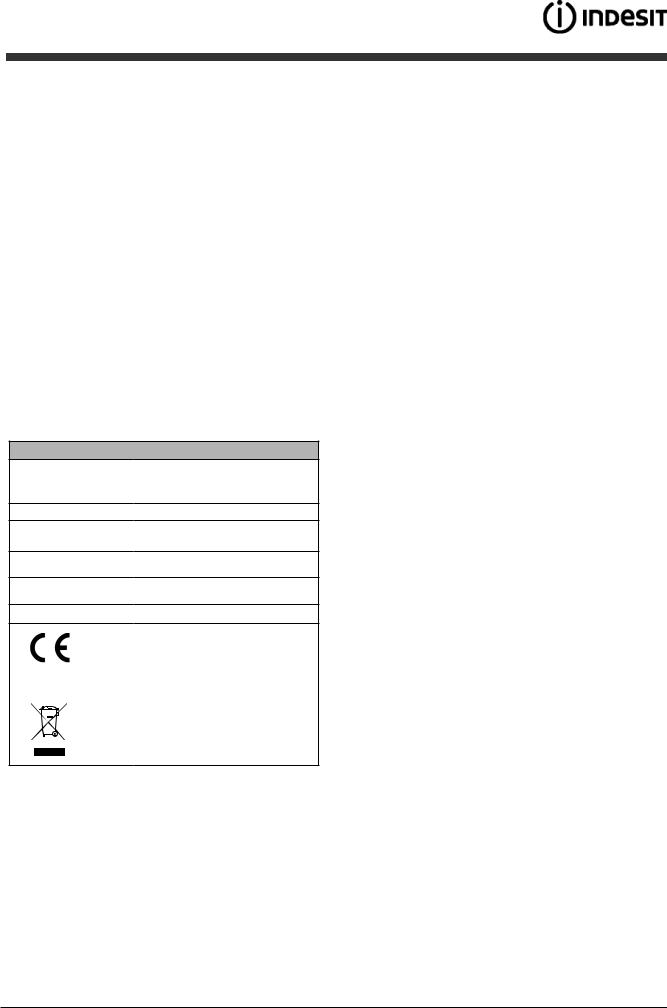
Cinta anticondensación*
Después de haber empotrado el lavavajillas, abra la puerta y pegue la cinta adhesiva transparente debajo de la superficie de madera para protegerla de una posible condensación.
Advertencias para el primer lavado
Después de la instalación, quite los tapones colocados en los cestos y los elementos elásticos de bloqueo del cesto superior (si existen).
Inmediatamente antes del primer lavado, llene completamente de agua el depósito de sal y agregue aproximadamente 1 kg. de sal (ver el capítulo Abrillantador y sal regeneradora): es normal que el agua se derrame. Seleccione el grado de dureza del agua
(ver el capítulo Abrillantador y sal regeneradora). - Después de la carga de sal, la luz indicadora de FALTA DE SAL* se apaga.
 Cuando no se llena el contenedor de sal, se puede dañar el ablandador de agua y el elemento que produce calor.
Cuando no se llena el contenedor de sal, se puede dañar el ablandador de agua y el elemento que produce calor.
Datos técnicos
ancho: 60 cm
Dimensiones altura: 85 cm profundidad: 60 cm
Capacidad
Presión del agua de alimentación
Tensión de
alimentación Potencia total
absorbida
Fusible
13 cubiertos estándar
0,05 ÷ 1MPa (0,5 ÷ 10 bar)
7,25 – 145 psi
Ver la placa de características
Ver la placa de características
Ver la placa de características
Este aparato es conforme a las siguientes Directivas de la Comunidad:
-2006/95/EC (Bajo Voltaje
- 2004/108/EC (Compatibilidad Electromagnética) -2009/125/EC (Comm. Reg. 1016/2010) (Ecodesign) -97/17/EC (etiquetado) -2012/19/EC (DEEE)
Asistencia Técnica |
|
ES |
|
|
|
Antes de llamar al Servicio de Asistencia Técnica:
•Verifique si la anomalía puede ser resuelta por Ud. mismo
(ver Anomalías y Soluciones).
•Vuelva a poner en funcionamiento el programa para controlar si el inconveniente ha sido resuelto.
•Si no es así, llame al Servicio de Asistencia Técnica
Autorizado.
 No llame nunca a técnicos no autorizados.
No llame nunca a técnicos no autorizados.
Comunique:
•el tipo de anomalía;
•el modelo de la máquina (Mod.);
•y el número de serie (S/N).
Esta información se encuentra en la placa de características ubicada en el aparato (ver Descripción del aparato).
La máquina dispone de señales sonoras/tonos (según el modelo de lavavajillas)) que indican la presión del mando: encendido, fin de ciclo, etc.
Los símbolos/testigos/indicadores luminosos presentes en el panel de control/display, pueden variar de color, parpadear o tener luz fija. (según el modelo de lavavajillas).
En el display* aparece información sobre el tipo de ciclo programado, la fase de lavado/secado, el tiempo residual, la temperatura, etc.
* Presente sólo en algunos modelos.
19
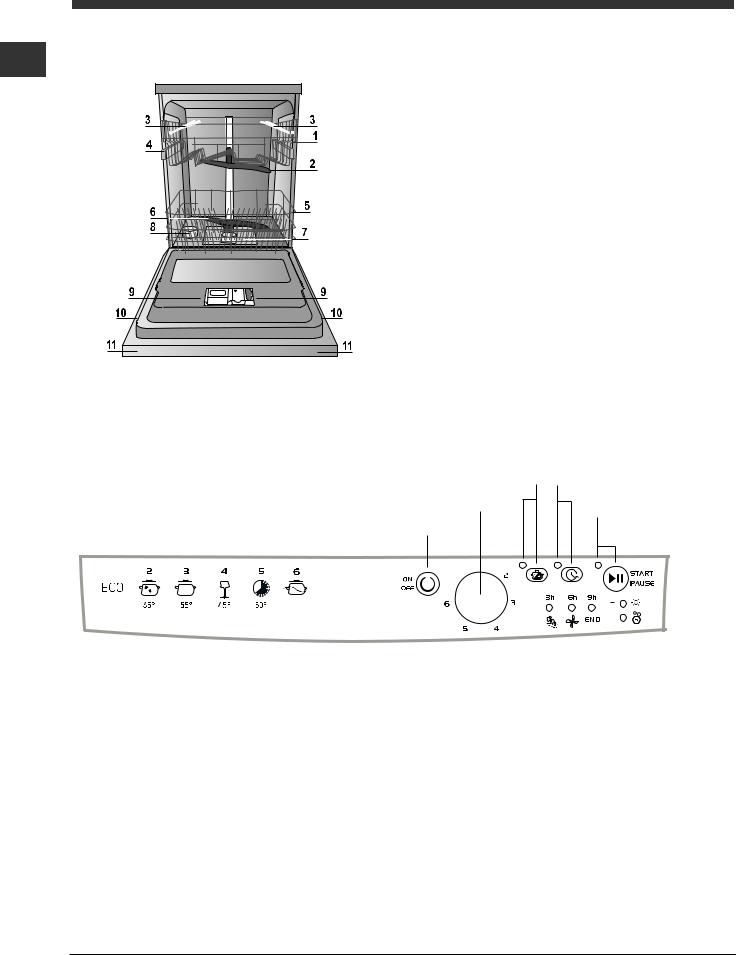
Descripción del aparato
ES |
Vista de conjunto |
|
1. Cesto superior
2. Rociador superior
3. Cestos adicionales
4. Regulación de la altura del cesto superior
5. Cesto inferior
6. Rociador inferior
7. Filtro de lavado
8. Depósito de sal
9. Cubeta de detergente, depósito de abrillantador y dispositivo de Active Oxygen*
10. Placa de características
11. Panel de mandos***
Panel de control
Botón y Piloto Media Carga
Botón de Selección de Programas
Botón On-Off/Reset
Botón y Piloto Inicio retrasado
Botón y Piloto Puesta en funcionamiento/Pausa
|
|
|
|
|
|
|
|
Piloto de falta de sal |
|
|
|
|
|
|
|
|
|
|
|
|
|
|
|
|
|
|
|
|
|
|
|
|
|
|
|
Piloto Lavado e Inicio Retrasado 3h. |
|
|
|
|
||||
|
|
|
|
|||||
|
|
|
|
|||||
|
|
|
|
|||||
Piloto Secado e Inicio Retrasado 6h. |
|
|
Piloto de falta |
|||||
Piloto Fin de programa e Inicio Retrasado 9h. |
|
de abrillantador |
||||||
|
|
|
||||||
|
|
|
|
|
|
|
|
|
*** Sólo en los modelos totalmente empotrados * Presente sólo en algunos modelos.
El número y el tipo de programas y opciones varían según el modelo de lavavajillas.
20
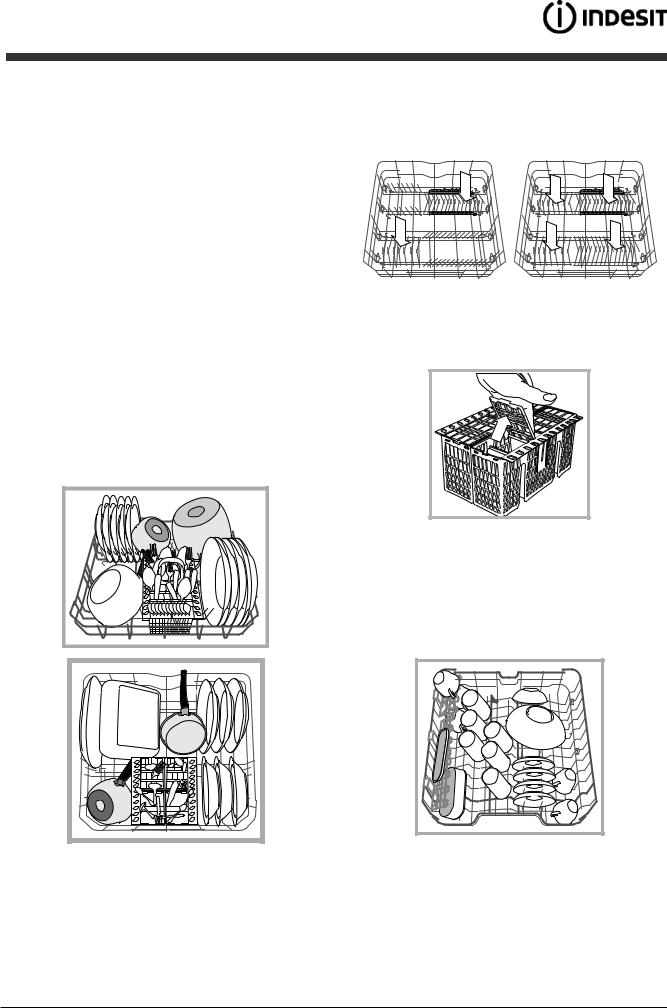
Cargar los cestos
Sugerencias
Antes de cargar los cestos, eliminar de la vajilla los residuos de alimentos y vaciar los vasos y las copas. No es necesario aclarar la vajilla con agua corriente.
Disponer la vajilla de manera que quede firme y no se vuelque. Los recipientes deben colocarse con la abertura hacia abajo y las partes cóncavas o convexas en posición oblicua, para permitir que el agua alcance todas las superficies y fluya.
Asegurarse de que las tapas, las asas, las sartenes y las bandejas no impidan la rotación de los rociadores. Colocar los objetos pequeños en el cesto de los cubiertos.
La vajilla de plástico y las sartenes antiadherentes tienden a retener las gotas de agua, por lo que quedarán menos secas que las vajillas de cerámica o acero.
Es conveniente colocar los objetos livianos (por ejemplo, los recipientes de plástico) en el cesto superior, de modo que no puedan moverse.
Una vez terminada la carga, comprobar que los rociadores giren libremente.
Cesto inferior
El cesto inferior puede contener ollas, tapas, platos, ensaladeras, cubiertos, etc. Los platos y las tapas grandes se deben colocar preferentemente a los costados.
Algunos modelos de lavavajillas tienen sectores reclinables*, |
ES |
||||
que se pueden utilizar en posición vertical, para colocar platos, |
|||||
|
|||||
u horizontal, para colocar ollas y ensaladeras. |
|
||||
|
|
|
|
|
|
|
|
|
|
|
|
|
|
|
|
|
|
|
|
|
|
|
|
Cesto de los cubiertos
El cesto de los cubiertos tiene rejillas superiores para facilitar la disposición. El cesto se debe colocar sólo en la parte delantera del cesto inferior.
 Los cuchillos y los utensilios con puntas cortantes se deben colocar con las puntas hacia
Los cuchillos y los utensilios con puntas cortantes se deben colocar con las puntas hacia
abajo o en los cestos adicionales del cesto superior en posición horizontal.
Cesto superior
Cargar la vajilla delicada y liviana: vasos, tazas, platitos, ensaladeras bajas.
Se recomienda poner la vajilla muy sucia en el cesto inferior, donde los chorros de agua son más enérgicos y permiten obtener mejores prestaciones de lavado.
Algunos modelos de lavavajillas tienen sectores reclinables*, utilizables en posición vertical para colocar platitos de té o de postre, o en posición horizontal para colocar escudillas y recipientes.
* Presente sólo en algunos modelos.
21
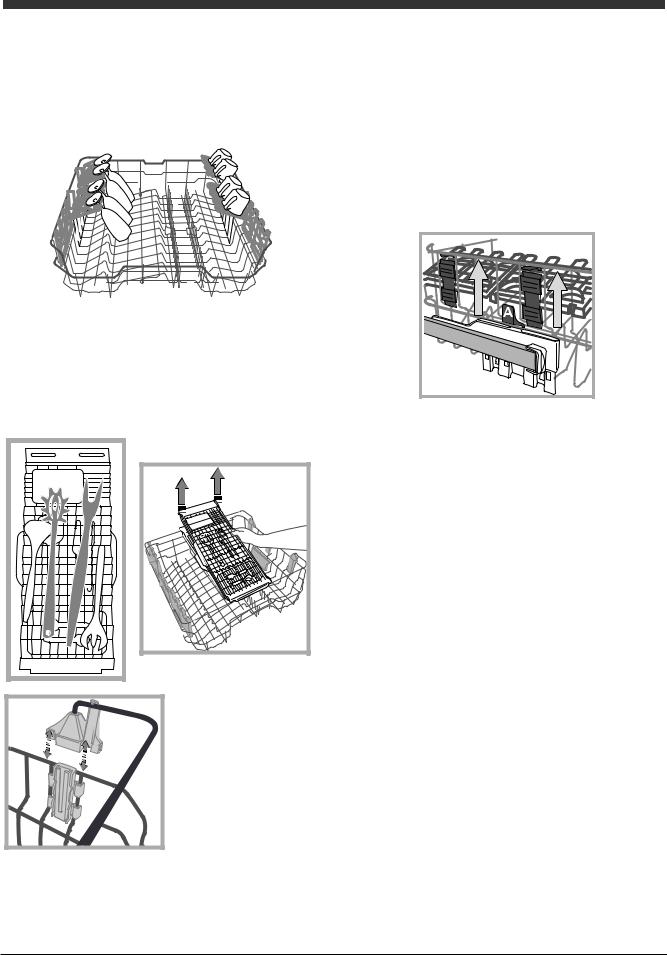
ES |
Cestos adicionales de posición variable |
|||||
Los cestos adicionales laterales se pueden colocar a tres alturas |
||||||
|
||||||
|
diferentes para optimizar la disposición de la vajilla en el cesto. |
|||||
|
||||||
|
Las copas se pueden colocar de forma estable en los |
|||||
|
cestos adicionales, introduciendo el pie en las ranuras |
|||||
|
correspondientes. |
|||||
|
|
|
|
|
|
|
|
|
|
|
|
|
|
|
|
|
|
|
|
|
|
|
|
|
|
|
|
Bandeja para cubiertos*
Algunos modelos de lavavajillas poseen una bandeja deslizable que se puede utilizar para contener cubiertos para servir o tazas de pequeñas dimensiones. Para mejores prestaciones de lavado, evite cargar vajilla voluminosa debajo de la bandeja.
La bandeja para cubiertos se puede extraer. (ver la figura)
Antes de cargar la bandeja, controle que los soportes estén bien enganchados en el cesto superior. (ver la figura)
* Presente sólo en algunos modelos.
El cesto superior es de altura regulable según las necesidades; la posición más alta facilita la disposición de vajillas voluminosas en el cesto inferior; la posición más baja permite aprovechar los espacios de los cestos adicionales y los sectores reclinables creando más espacio hacia arriba.
Regular la altura del cesto superior
Para facilitar la colocación de la vajilla, el cesto superior se puede ubicar en posición alta o baja.
Es preferible regular la altura del cesto superior con el CESTO VACÍO.
No levantar ni bajar el cesto de un solo lado.
Si el cesto tiene Lift-Up* (ver la figura), sujetarlo por los costados y levantarlo. Para volver a la posición inferior, pulsar las palancas (A) a los costados del cesto y acompañarlo hacia abajo.
Vajillas no aptas para el lavado en lavavajillas
•Cubiertos y vajillas de madera.
•Vasos decorados delicados, vajillas artesanales y antigüedades. Las decoraciones no son resistentes.
•Partes en material sintético no resistentes a la alta temperatura.
•Vajilla de cobre o estaño.
•Vajilla sucia de ceniza, cera, grasa lubricante o tinta.
Las decoraciones sobre vidrio, aluminio y plata durante el lavado pueden cambiar de color o descolorarse. Ciertos tipos de vidrio
(por ejemplo, los objetos de cristal) después de muchos lavados pueden perder brillo.
Daños al vidrio y a la vajilla
Causas:
•Tipo de vidrio y procedimiento de producción del vidrio.
•Composición química del detergente.
•Temperatura del agua del programa de aclarado. Consejo:
•Utilizar sólo vasos y porcelana cuya resistencia al lavado en lavavajillas esté garantizada por el fabricante.
•Utilizar detergente delicado para vajilla.
•Sacar los vasos y los cubiertos del lavavajillas lo más pronto posible al finalizar el programa.
22
